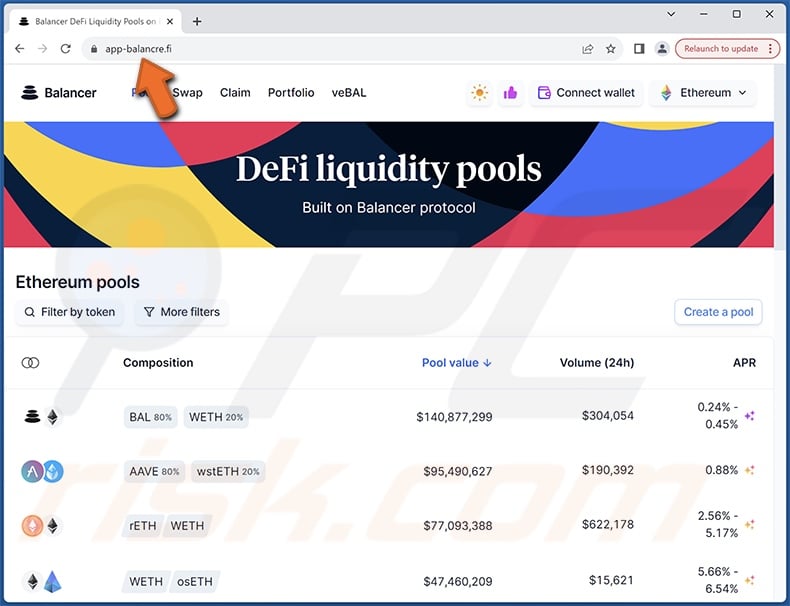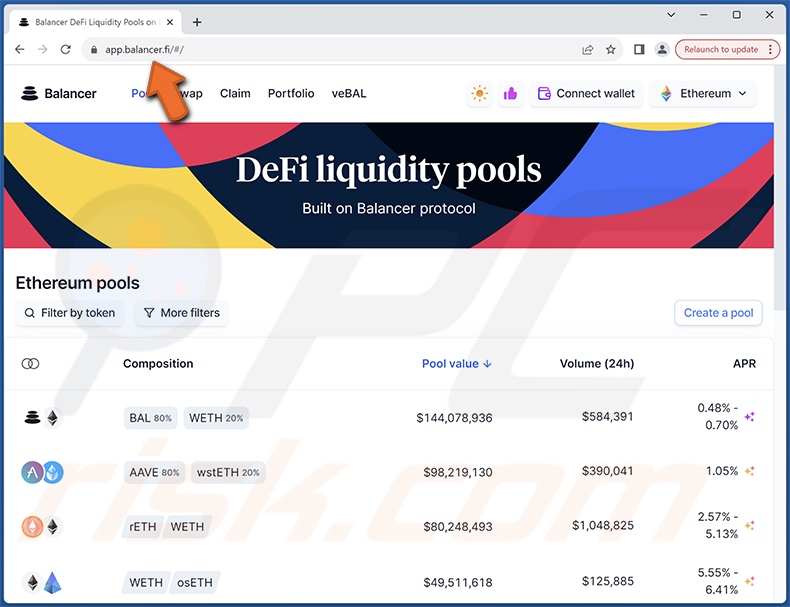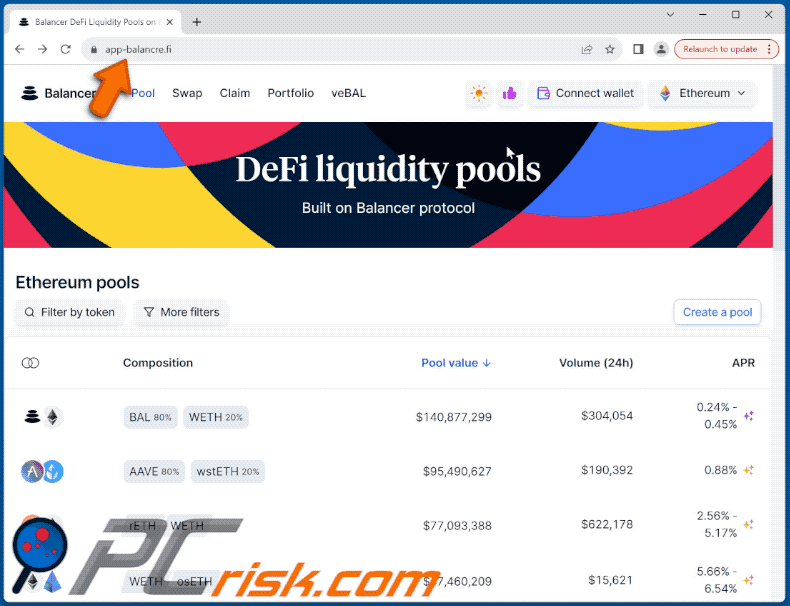Avoid losing your cryptocurrency to fake Balancer websites
Phishing/ScamAlso Known As: "Balancer" crypto drainer
Get free scan and check if your device is infected.
Remove it nowTo use full-featured product, you have to purchase a license for Combo Cleaner. Seven days free trial available. Combo Cleaner is owned and operated by RCS LT, the parent company of PCRisk.com.
What kind of scam is "Balancer"?
After inspecting this Balancer website, we determined that it is fake. It imitates the official platform's site, both its graphics and domain. Once a user tries to interact with the imitator webpage, they are immediately requested to connect their digital wallet – and by doing so, they will inadvertently initiate a cryptocurrency-draining mechanism.

"Balancer" scam overview
The fraudulent Balancer webpage that we investigated closely mimicked the appearance of the legitimate site. The real Balancer is a decentralized Automated Market Maker (AMM) protocol platform built on the Ethereum blockchain. As an AMM, this platform allows automatic trading by utilizing liquidity pools rather than relying on a buyer/seller market.
Additionally, the fake site – app-balancre[.]fi – spoofed the official website's domain, which is app.balancer.fi. The change in letter placement is a typosquatting technique that aims to catch visitors who mistype the genuine site's URL. However, it is pertinent to mention that this scam content could be hosted on other domains as well.
Whenever the bogus Balancer page is interacted with (e.g., any of the buttons are clicked), a prompt to connect a digital wallet is displayed. If a victim does so – the scam begins operating as a crypto drainer. To elaborate, automatic outgoing transactions from the exposed wallet are triggered.
Some drainers can approximate the value of stored digital assets – thus, they can prioritize those of the greatest value. The transactions may also be disguised and made to sound vague so as to lower victim suspicion. Therefore, the wallets can be drained of highly precious funds or emptied in their entirety. The scope of the financial loss depends on the value of the stolen assets.
It must be mentioned that due to the practically untraceable nature of cryptocurrency transactions – they cannot be reversed, and victims are unable to retrieve their funds.
| Name | "Balancer" crypto drainer |
| Threat Type | Phishing, Scam, Social Engineering, Fraud |
| Disguise | Balancer platform |
| Related Domains | app-balancre[.]fi |
| Detection Names (app-balancre[.]fi) | Emsisoft (Phishing), Fortinet (Phishing), Kaspersky (Phishing), Netcraft (Malicious), Full List Of Detections (VirusTotal) |
| Serving IP Address (app-balancre[.]fi) | 172.67.157.1 |
| Distribution methods | Typosquatting, spam, compromised websites, rogue online pop-up ads, potentially unwanted applications. |
| Damage | Monetary loss |
| Malware Removal (Windows) |
To eliminate possible malware infections, scan your computer with legitimate antivirus software. Our security researchers recommend using Combo Cleaner. Download Combo CleanerTo use full-featured product, you have to purchase a license for Combo Cleaner. 7 days free trial available. Combo Cleaner is owned and operated by RCS LT, the parent company of PCRisk.com. |
Cryptocurrency drainer scam examples
"PayPal Stablecoin", "Claim EZPOINTS", "Layer Bank MANTA Airdrop", "Seiyans Mint", and "Blast Airdrop" are just some examples of crypto drainers we have examined recently.
There are three main types of cryptocurrency-centric scams – drainers, fake giveaways/airdrops that promise a multiplied return on transferred cryptocurrency, and phishing schemes targeting wallet log-in credentials.
There are countless other types of scams online. Regardless of what false claims or mechanisms they use, their end goal is the same – to generate revenue for cyber criminals.
How did I open a scam website?
The fake Balancer webpage we examined had an address closely resembling the legitimate platform's domain, suggesting a typosquatting technique. In other words, when a user misspells the actual Balancer website's URL – they access the imitator page. Note that other domains and methods may used to promote this scam.
Aside from typosquatting, online scams are commonly pushed via spam (e.g., emails, social media posts, PMs/DMs, SMSes, browser notifications, etc.), websites using rogue advertising networks, intrusive ads, and adware.
How to avoid visiting scam websites?
It is paramount to be vigilant when browsing since fraudulent and dangerous online content usually appears legitimate and harmless. Intrusive advertisements and spam browser notifications are examples of this, as despite looking innocuous – they redirect users to unreliable and dubious sites (e.g., scam-promoting, gambling, pornography, etc.).
We recommend paying attention to URLs and typing them carefully. Be selective about which webpages you allow to display browser notifications. Do not permit suspicious pages to do so (i.e., do not click "Allow", "Allow Notifications", etc.), and instead ignore or deny notification requests (i.e., select "Block", "Block Notifications", etc.).
We advise against using websites that offer pirated software/media or other questionable services (e.g., Torrenting, illegal streaming or downloading, etc.), as they are typically monetized via rogue advertising networks. Another recommendation is to treat incoming messages with caution and not open attachments/links found in suspect mail.
To prevent bundled/harmful content from infiltrating the device – download only from official/verified sources and be attentive when installing software (e.g., read terms, study options, use "Custom/Advanced" settings, and opt out of additional apps, extensions, features, etc.).
If your computer is already infected, we recommend running a scan with Combo Cleaner Antivirus for Windows to automatically eliminate all threats.
Screenshot of the legitimate Balancer website (app.balancer.fi):

The appearance of "Balancer" scam (GIF):

Instant automatic malware removal:
Manual threat removal might be a lengthy and complicated process that requires advanced IT skills. Combo Cleaner is a professional automatic malware removal tool that is recommended to get rid of malware. Download it by clicking the button below:
DOWNLOAD Combo CleanerBy downloading any software listed on this website you agree to our Privacy Policy and Terms of Use. To use full-featured product, you have to purchase a license for Combo Cleaner. 7 days free trial available. Combo Cleaner is owned and operated by RCS LT, the parent company of PCRisk.com.
Quick menu:
- What is "Balancer" crypto drainer?
- How to identify a pop-up scam?
- How do pop-up scams work?
- How to remove fake pop-ups?
- How to prevent fake pop-ups?
- What to do if you fell for a pop-up scam?
How to identify a pop-up scam?
Pop-up windows with various fake messages are a common type of lures cybercriminals use. They collect sensitive personal data, trick Internet users into calling fake tech support numbers, subscribe to useless online services, invest in shady cryptocurrency schemes, etc.
While in the majority of cases these pop-ups don't infect users' devices with malware, they can cause direct monetary loss or could result in identity theft.
Cybercriminals strive to create their rogue pop-up windows to look trustworthy, however, scams typically have the following characteristics:
- Spelling mistakes and non-professional images - Closely inspect the information displayed in a pop-up. Spelling mistakes and unprofessional images could be a sign of a scam.
- Sense of urgency - Countdown timer with a couple of minutes on it, asking you to enter your personal information or subscribe to some online service.
- Statements that you won something - If you haven't participated in a lottery, online competition, etc., and you see a pop-up window stating that you won.
- Computer or mobile device scan - A pop-up window that scans your device and informs of detected issues - is undoubtedly a scam; webpages cannot perform such actions.
- Exclusivity - Pop-up windows stating that only you are given secret access to a financial scheme that can quickly make you rich.
Example of a pop-up scam:

How do pop-up scams work?
Cybercriminals and deceptive marketers usually use various advertising networks, search engine poisoning techniques, and shady websites to generate traffic to their pop-ups. Users land on their online lures after clicking on fake download buttons, using a torrent website, or simply clicking on an Internet search engine result.
Based on users' location and device information, they are presented with a scam pop-up. Lures presented in such pop-ups range from get-rich-quick schemes to fake virus scans.
How to remove fake pop-ups?
In most cases, pop-up scams do not infect users' devices with malware. If you encountered a scam pop-up, simply closing it should be enough. In some cases scam, pop-ups may be hard to close; in such cases - close your Internet browser and restart it.
In extremely rare cases, you might need to reset your Internet browser. For this, use our instructions explaining how to reset Internet browser settings.
How to prevent fake pop-ups?
To prevent seeing pop-up scams, you should visit only reputable websites. Torrent, Crack, free online movie streaming, YouTube video download, and other websites of similar reputation commonly redirect Internet users to pop-up scams.
To minimize the risk of encountering pop-up scams, you should keep your Internet browsers up-to-date and use reputable anti-malware application. For this purpose, we recommend Combo Cleaner Antivirus for Windows.
What to do if you fell for a pop-up scam?
This depends on the type of scam that you fell for. Most commonly, pop-up scams try to trick users into sending money, giving away personal information, or giving access to one's device.
- If you sent money to scammers: You should contact your financial institution and explain that you were scammed. If informed promptly, there's a chance to get your money back.
- If you gave away your personal information: You should change your passwords and enable two-factor authentication in all online services that you use. Visit Federal Trade Commission to report identity theft and get personalized recovery steps.
- If you let scammers connect to your device: You should scan your computer with reputable anti-malware (we recommend Combo Cleaner Antivirus for Windows) - cyber criminals could have planted trojans, keyloggers, and other malware, don't use your computer until removing possible threats.
- Help other Internet users: report Internet scams to Federal Trade Commission.
Frequently Asked Questions (FAQ)
What is an online scam?
Online scams refer to deceptive content promoted on the Web, which is intended to lure users into performing specific actions. For example, victims may be enticed/scared into connecting their digital wallets to crypto drainers, making monetary transactions, subscribing to services, purchasing products, disclosing vulnerable information, calling fake support lines, allowing cyber criminals to access devices remotely, and so forth.
What is the purpose of online scams?
The goal of scams is to generate revenue at victims' expense. Cyber criminals profit predominantly by obtaining funds through deception, endorsing content (e.g., websites, software, products, etc.), selling/abusing private data, and proliferating malware.
I have lost cryptocurrency to the "Balancer" scam, can I get my money back?
No, due to the practically untraceable nature of these transactions – they cannot be reversed.
Why do I encounter online scams?
Online scams are most commonly promoted via mistyped URLs (typosquatting), sites using rogue advertising networks, spam (e.g., social media posts, emails, DMs/PMs, SMSes, browser notifications, etc.), intrusive advertisements, and adware.
Will Combo Cleaner protect me from online scams?
Combo Cleaner is designed to scan visited websites and detect rogue, scam, and malicious ones. Hence, if you enter such a webpage – you will be warned immediately, and further access to it will be denied.
Share:

Tomas Meskauskas
Expert security researcher, professional malware analyst
I am passionate about computer security and technology. I have an experience of over 10 years working in various companies related to computer technical issue solving and Internet security. I have been working as an author and editor for pcrisk.com since 2010. Follow me on Twitter and LinkedIn to stay informed about the latest online security threats.
PCrisk security portal is brought by a company RCS LT.
Joined forces of security researchers help educate computer users about the latest online security threats. More information about the company RCS LT.
Our malware removal guides are free. However, if you want to support us you can send us a donation.
DonatePCrisk security portal is brought by a company RCS LT.
Joined forces of security researchers help educate computer users about the latest online security threats. More information about the company RCS LT.
Our malware removal guides are free. However, if you want to support us you can send us a donation.
Donate
▼ Show Discussion